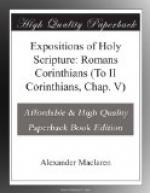But then, let me remind you still further, that not only does the life of Christ, as sinless in the midst of sinful men, and the life of Christ, as sinless whilst yet there was temptation presented to it—assume the aspect of being a life of suffering, and become, in that respect, the model for us; but that also the Death of Christ, besides its aspect as an atonement and sacrifice for sin, the power by which transgression is put away and God’s love flows out upon our souls, has another power given to it in the teaching of the New Testament. The Death of Christ is a type of the Christian’s life, which is to be one long, protracted, and daily dying to sin, to self, to the world. The crucifixion of the old manhood is to be the life’s work of every Christian, through the power of faith in that Cross by which ‘the world is crucified unto Me, and I unto the world.’ That thought comes over and over again in all forms of earnest presentation in the Apostle’s teaching. Do not slur it over as if it were a mere fanciful metaphor. It carries in its type a most solemn reality. The truth is, that, if a Christian, you have a double life. There is Christ, with His power, with His Spirit, giving you a nature which is pure and sinless, incapable of transgression, like His own. The new man, that which is born of God, sinneth not, cannot sin. But side by side with it, working through it, working in it, leavening it, indistinguishable from it to your consciousness, by anything but this that the one works righteousness and the other works transgression, there is the ‘old man,’ ‘the flesh,’ ’the old Adam,’ your own godless, independent, selfish, proud being. And the one is to slay the other! Ah, let me tell you, these words—crucifying, casting out the old man, plucking out the right eye,




